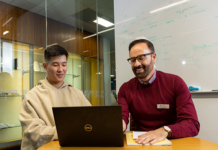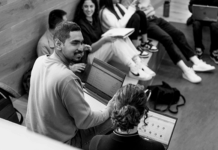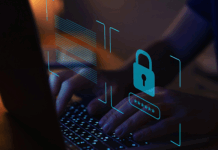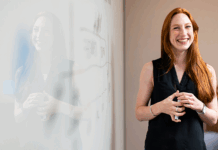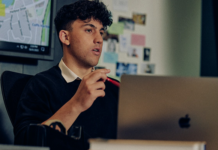Return-to-campus anxiety
As students begin to return to campus and engage more with hybrid learning, it is normal to struggle with adapting to a new learning environment (yet again!). Many students have gotten used to studying in a certain environment and the idea of coming onto campus can be a daunting one. Psychologist Chiara Dargin from Strategy, Education & Prevention shares some tips for easing anxiety about returning to campus.
University students are no strangers to anxiety with 11.2% of students having a diagnosed anxiety disorder and 5% of students reporting they were often or always worried. More than two-fifths (42.3%) of students had experienced serious personal, emotional, behavioural or mental health problem for which they needed professional help. While students are excited to return to campus, meet their peers face to face and sit in a lecture theatre – even this welcome change can cause some anxiety.
What is anxiety?
Symptoms relating to anxiety can be emotional, behavioural, physical or cognitive (thought-based) and can prevent us from engaging in our lives the way we would like to. Some examples of anxiety are:
- Emotional: irritability, feelings of dread, worry, nervousness, restlessness
- Behavioural: isolation, avoidance, difficulty concentrating, memory problems
- Cognitive: planning worst-case scenario, all or nothing thinking, over generalizing, using ‘should’ statements and jumping to conclusions
- Physical: shortness of breath, nausea/diarrhea, headaches/body aches, fatigue, chest tightness
Some concerns you might have around returning to campus might include fears around contracting COVID-19, anxiety around not knowing where classes are, increased fatigue due to increased travel time, less productivity, and issues with time management.
Here are some tips for easing anxiety about returning to campus:
- Acknowledge your fear
Sometimes we can block our emotions because they feel too difficult or too uncomfortable which can place additional stress on our mind and our body, sometimes even making them worse. Acknowledging them and not “beating up on yourself” can be the first step in letting anxiety and stress go.- Stop – take a moment to stop, put down the phone, turn off the computer, close the study books and just be with you.
- Name It – ask yourself “what are you feeling right now?”. Start by describing the physical sessions (e.g., tight chest, upset tummy, heavy limbs, shaky head etc.) and then do the same with your emotions and feelings (e.g., sad, tired, angry, hurt, overwhelmed etc.). Saying this out loud to yourself or to a trusted person can be supportive.
- Explore the Cause – ask yourself “why am I feeling this way?”. Did something happen? Did someone say something? Am I avoiding something? Am I scared of something? Sometimes we can’t always put our finger on the ‘why’, that’s okay. If the answer doesn’t come, give it some space and move onto the next step.
- Make a Move – ask yourself “what can I do right now to support myself?”. We may not know why we’re feeling the way we are and we may not be able to immediately fix or stop it, but we can choose how we’re going to be with it. Go for a walk, connect with a friend, prepare a nourishing meal, take a nap, complete some homework, go out to a café, do the thing you’re avoiding – understand what is will be supportive for you in the moment.
- Stop – take a moment to stop, put down the phone, turn off the computer, close the study books and just be with you.
- Clear to neutral
A 2021 study found that individuals who mindfully approached their feelings reported less anxiety about the coronavirus. Mindfulness practices involve learning to be present in the moment and recognizing how you feel. You can apply this practice to the current coronavirus pandemic by accepting reality as it is now.
Stopping to take a minute to do some deep breathing, connect to your body and allow yourself to feel your breath entering the body. Feel it deep in your lungs, even imagining it going down to your belly button. Count to 5 in your head on your inhale and on your exhale; do this 10 times in a row. Try listening to this 2 minute Breath Bubble exercise for a visual and audio aid.
- Get to know your campus
Download the Lost on Campus app, which is Australia’s largest campus mapping app. This app has maps for each of our university campuses. Using the app you can search for rooms, lecture theatres, labs and offices.
You can also take a virtual tour of your campus on the Latrobe website.
- Accommodate for travelling time
“Time I would have used to do study, I now need for travelling” (Tadi – current student)
Travelling to campus for in-person classes can be exciting as this is something that some students have yet to experience. However, traveling can take up time in our day that we aren’t used to accounting for! This means you will need to accommodate this time into your study schedule for the day. But this doesn’t need to be wasted time.
Catching public transport is a great way to be able to use this time to your advantage by catching up on readings or skimming over notes. Use the PTV journey planner to find the quickest way to uni or download the TramTracker app.
For those driving to campus, try listening to a podcast relevant to your field of study or even listen to your lecture whilst driving.
Remember to plan your trip to avoid traffic (especially during peak hour), use Maps to stay off busy roads and try leave for uni before peak hour.
- Conserve your energy & block your time
Prepping meals, travelling, unpacking, setting up your study space are all things that take energy and effort. It is normal to be feeling more tired than usual if you are coming onto campus for your classes.
Identify your most productive times of the day; is it first thing in the morning, middle of the day once your brain has woken up, or are you a night owl? Schedule your high (and low) energy work times around when you are most (and least) alert and productive.
After intense labs or tutorials, try scheduling down time or completing things such as calls and emails when your energy is low. One way to do this is by using time blocking, check out these free time blocking templates to start mapping out your days and prevent burnout from occurring.
- Distance from media
Social media can be a great way to connect with family and friends, and give us a sense of belonging. But too much social media use can negatively impact on student’s mental health. Social media algorithms can also fill your feed with headlines that can feel anxiety-inducting thoughts.
If you notice yourself feeling anxious after a social media or news session, it might be worthwhile reducing the amount of time you spend on social media. You can place a time restriction on selected apps, or when you would usually be on social media, reach out to a friend instead.
- Focus on the things you can control
The last two years has caused an overwhelming sense of vulnerability and lack of control. Try to focus on the things that you can do, such as:- wearing a mask whilst on campus
- washing your hands regularly throughout the day
- planning and bringing your meals along to campus
- getting quality sleep each night
These behaviours promote good hygiene or support a healthy immune system. If you do happen to get sick, notify your tutors & lecturers as soon as you can and reach out to Student Wellbeing Connect who can support you so that it has the least impact on your studies.
Want to learn more about mental health and strategies to support wellbeing? Enrol into the subject “Enhancing & Responding to Mental Health (For Students)”.
Student Wellbeing Connect is available to support any enrolled student who is experiencing personal or practical difficulties following a diagnosis of COVID for themselves, their family members or their household.
The service can provide emotional support or advice around managing academic issues and practical daily life issues. You can access this service on the Health, Wellbeing and Inclusion webpage.
